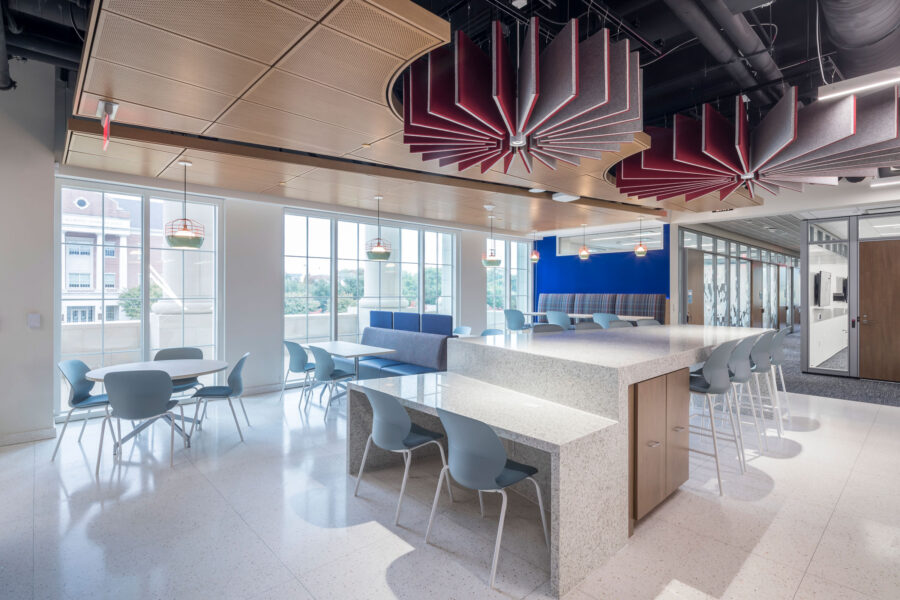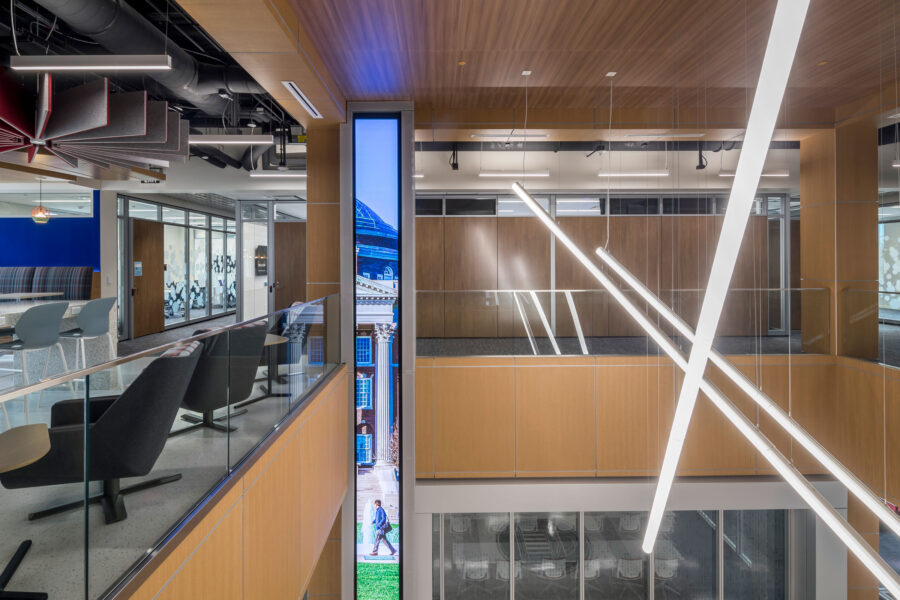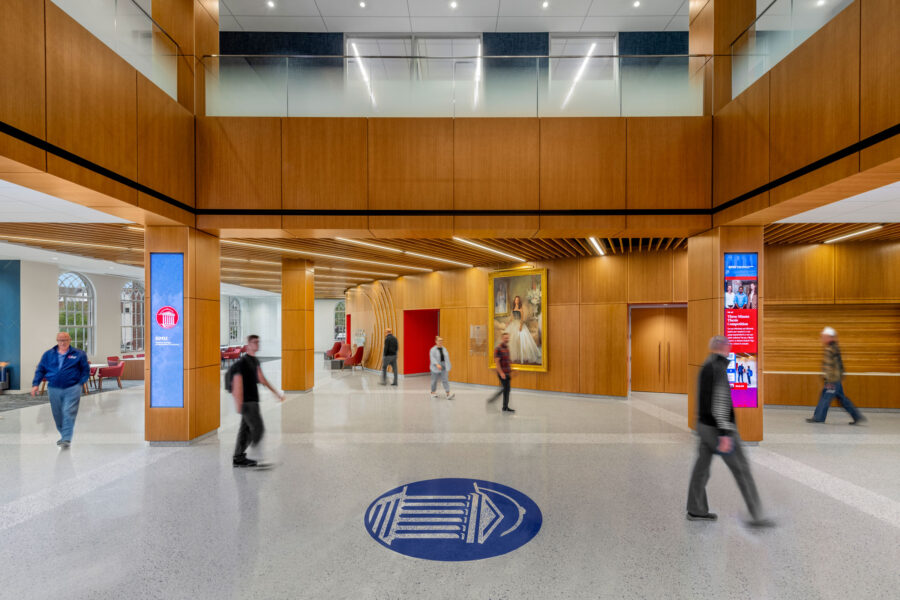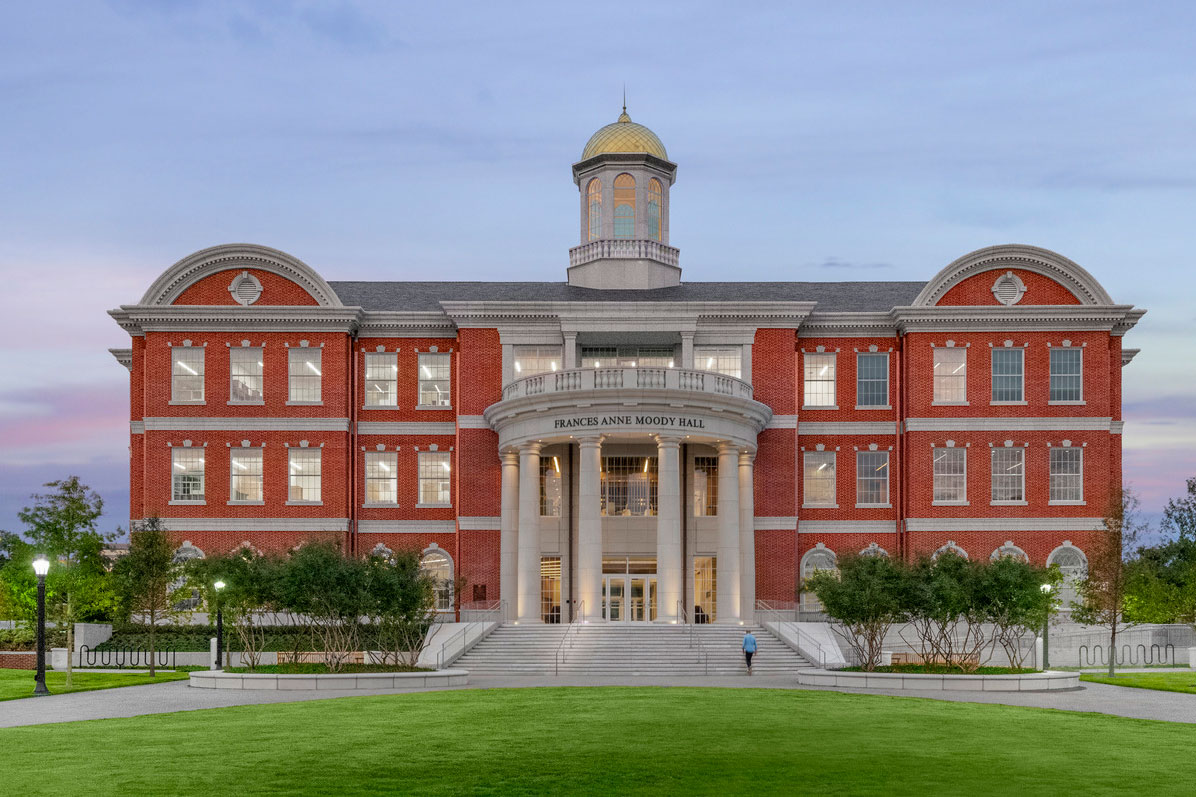Story at a glance:
- Buildings account for 42% of global greenhouse gas emissions every year.
- The AEC industry continues to need to rethink traditional building design and construction approaches.
Despite our efforts the AEC industry is falling short of meeting sustainability and emissions reduction goals, like the AIA 2030 Commitment, which is now only six years away. Even the best energy codes in the US promise a modest 60 to 65% reduction in energy use.
This sobering reality emphasizes the need to rethink traditional building design and construction approaches.
Collaboration among architects, engineers, contractors, policymakers, and stakeholders is key to mitigating environmental degradation and integrating sustainable practices into every aspect of the built environment.
Advancing Global Sustainability

Aesthetic acoustic elements and plentiful natural light are seen inside the Gerald J. Ford project. Photo courtesy of The Beck Group
Governmental regulations create baseline sustainability practices for building performance, energy efficiency, and the environmental impact of new construction and major renovations. By mandating compliance, regulators drive widespread adoption of sustainable design and construction practices. In some jurisdictions tax breaks, grants, or expedited permitting processes encourage developers, builders, and property owners to voluntarily invest in sustainable building practices.
Others may opt to pursue green building rating systems. These rating systems provide independent assessments of a building’s performance and evaluate various aspects of design, construction, operation, and maintenance. Improvements in energy efficiency, water conservation, indoor air quality, and materials selection help differentiate properties in the marketplace. Building owners and developers demonstrate their commitment to sustainability by obtaining certification from these programs.
Regulation and third-party green building rating systems are complementary in advancing global sustainability. Together they establish standards, provide incentives, validate performance, drive market transformation, and foster innovation. By effectively leveraging these mechanisms, stakeholders can accelerate the mitigation of environmental impacts and address the challenges of climate change on a global scale.
The Big Picture

Gerald J Ford Hall is an interdisciplinary research hub that equips faculty, students, and industry partners with tools and resources to collaborate, solve complex problems, and power new enterprises. Photo courtesy of The Beck Group
It’s easy to focus on the individual building when it is often an entire project scope. However, zooming out to a broader region, we see how improved building codes and rating systems improve cities and whole geographic locations.
LEED for Cities and Communities, for example, helps local governments and the private sector track progress toward large-scale sustainability goals and allows comparison with other cities worldwide. The strategies influence decision-making for citywide progress and resource efficiency that helps conserve energy and water, improve mass transit infrastructure, and reduce waste and pollution. Committing to environmental stewardship enhances air and water quality while prioritizing human health and economic development for more livable and sustainable communities.
However, we often focus these efforts only on new construction projects.
The decision to demolish buildings in the United States instead of reusing them stems from economic, regulatory, cultural, and practical factors. While adaptive reuse offers numerous environmental and social benefits, in many cases, the cost of renovating an existing building can outweigh the cost of demolishing it and constructing a new one.
As environmental awareness has grown over the last few years, so have consumer preferences for sustainability.
Tenants, occupants, and investors increasingly prioritize environmentally responsible buildings when making leasing or purchasing decisions. As a result the AEC industry continually pushes the boundaries of sustainability, developing more efficient and environmentally friendly building solutions.
The Challenges

Ceiling raceways, demountable partitions, and movable lighting were among the design elements incorporated into the Gerald J. Ford project, planned for future technology and adaptive reuse. Photo courtesy of The Beck Group
Outdated infrastructure, structural deficiencies, and incompatible layouts may necessitate extensive remodeling. Depending on a building’s age regulations and zoning ordinances may also pose obstacles.
Historic preservation laws, environmental regulations, and land-use restrictions may limit the modifications that can be made to existing structures. Addressing these challenges adds complexity, time, and cost to projects. Developers and property owners may opt for demolition and new construction to avoid extra expenses and streamline development.

Gerald J Ford Hall is an interdisciplinary research hub that equips faculty, students, and industry partners with tools and resources to collaborate, solve complex problems, and power new enterprises. Photo courtesy of The Beck Group
Additionally, there may be perceptions that new construction offers greater flexibility and customization options compared to adapting existing buildings. Market demand also plays a significant role in driving decisions. In areas with high demand for new development, developers prioritize new construction to meet market needs. This is compounded by cultural or aesthetic preferences when a contemporary design is desired to reflect current trends and architectural styles.
As we build future-proof buildings, we must consider the whole building’s lifespan.
Despite these challenges, adaptive reuse is embraced because it minimizes the environmental impact of resource use and waste generation, saves on labor and materials, and contributes to neighborhood revitalization. As the climate crisis continues, we can no longer use the excuse that new construction projects offer the greatest opportunities to implement cutting-edge technology and sustainable solutions.
Embracing Modern Buildings

Frances Anne Moody Hall. Photo courtesy of The Beck Group
Each structure can be a tangible manifestation of our commitment to global sustainability. As we build future-proof buildings, we must consider the whole building’s lifespan.
Prioritizing energy efficiency, sustainable materials, and water conservation is not enough. We need to expand our design and construction approach to emphasize material durability, long-term maintenance, future adaptability, eventual building demolition, and material recyclability.
With these strategies implemented each building becomes a catalyst for positive change, demonstrating that environmentally preferable practices are feasible and economically viable.
In the face of mounting environmental threats, the urgency of sustainable construction cannot be overstated. Every decision in the design and construction process has far-reaching consequences for future generations. By collaborating across disciplines and thinking about individual projects as part of the urban fabric, we can transform our built environment and collectively contribute to scaling global efforts to combat climate change for a resilient and responsible future.




